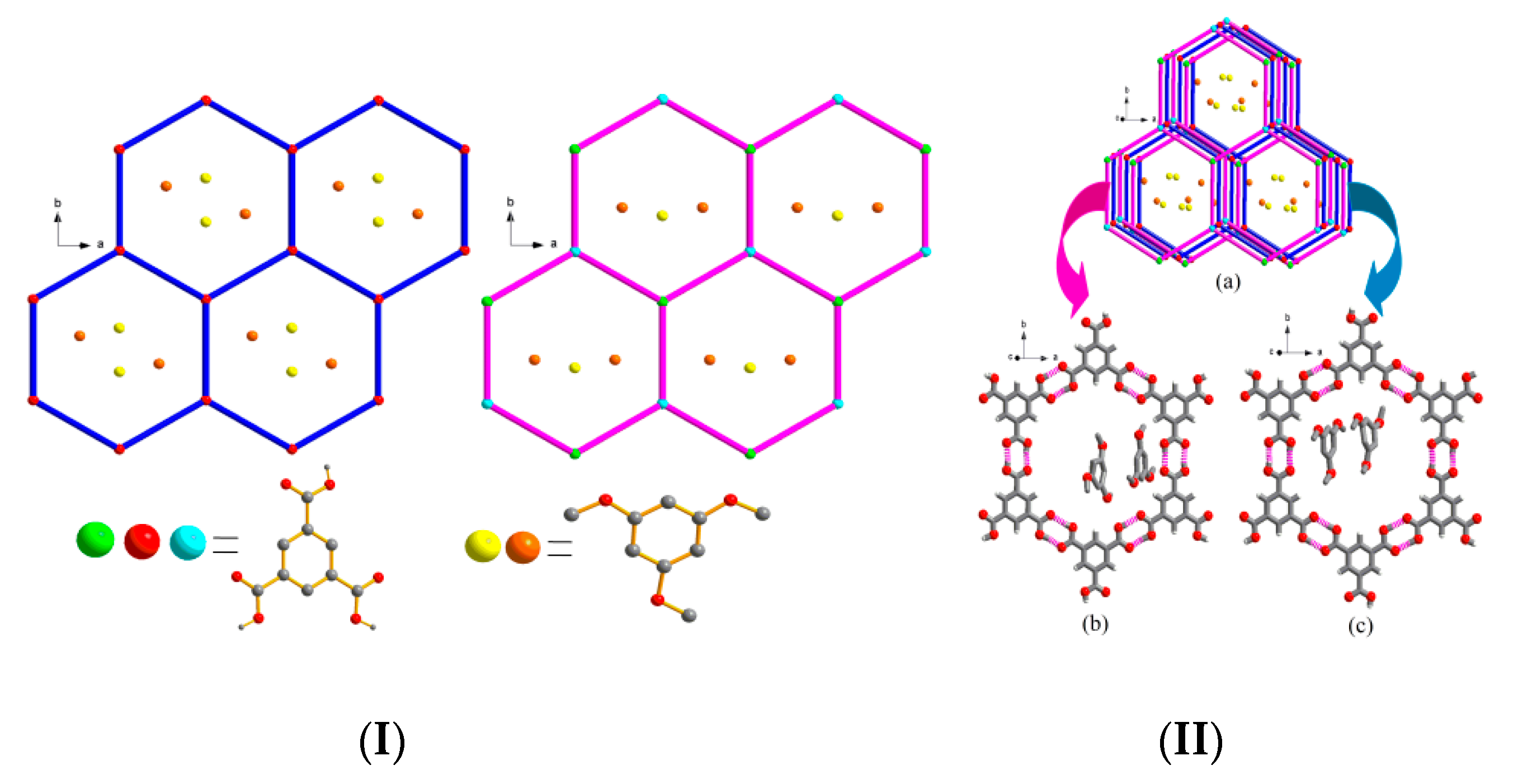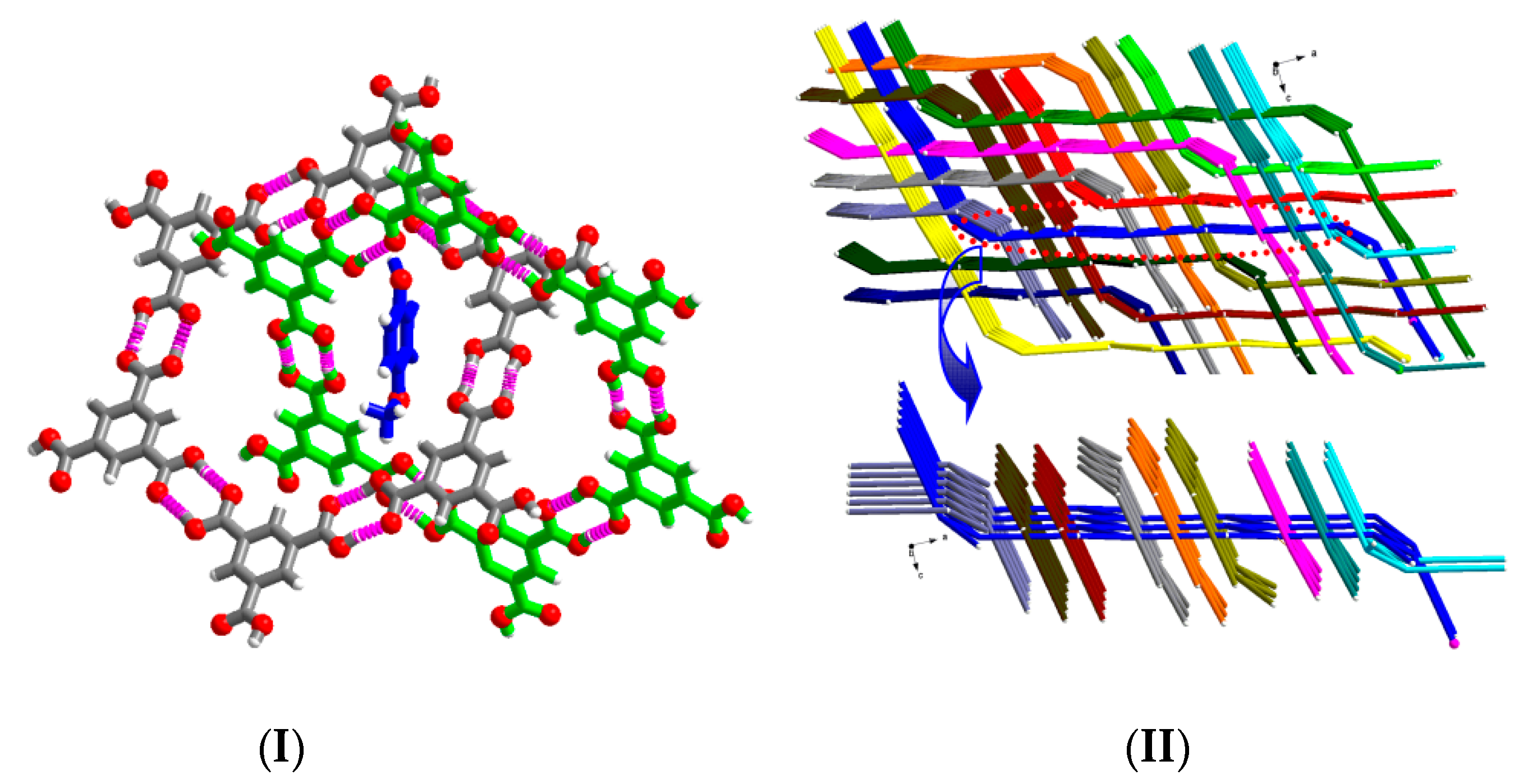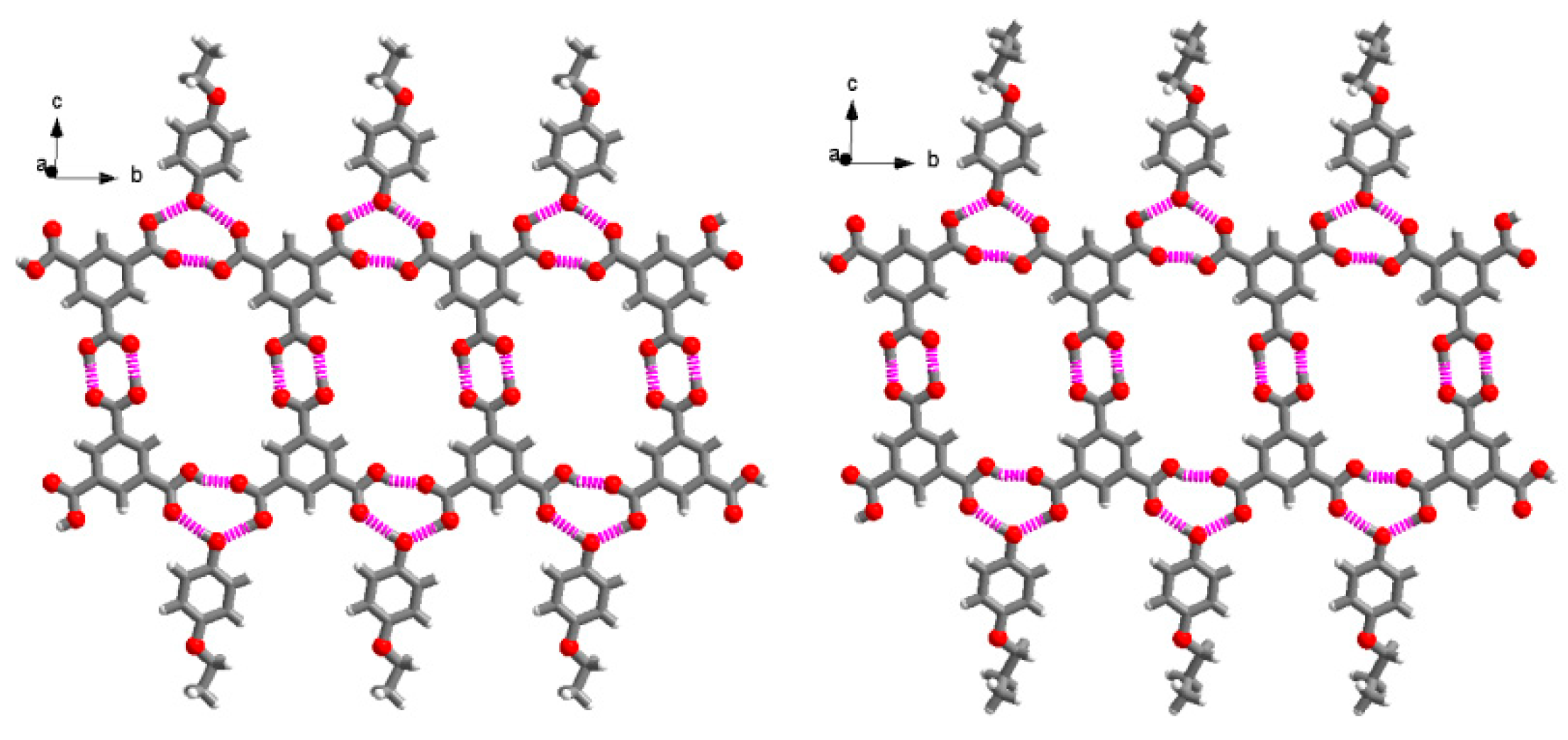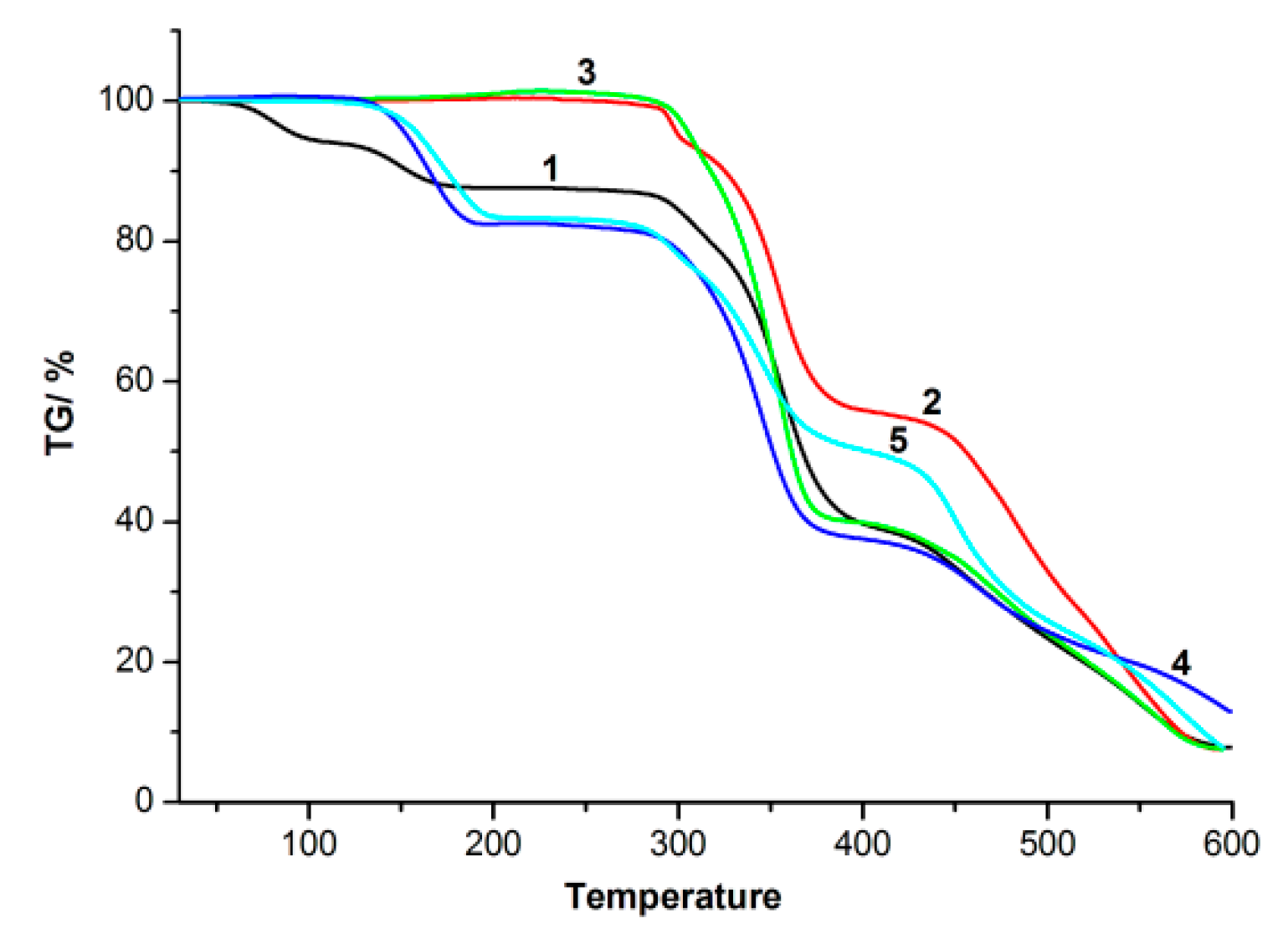Phenol Derivatives as Co-Crystallized Templates to Modulate Trimesic-Acid-Based Hydrogen-Bonded Organic Molecular Frameworks
Abstract
:1. Introduction
2. Materials and Methods
2.1. Preparation of the Compounds
2.2. Crystal Structure Determination
3. Results and Discussion
3.1. Description of Structures
3.1.1. Quaternary Compound [(TMA)4·(TMB)3] (1)
3.1.2. Quaternary Compound [(TMA)2·(DMB)1.5] (2)
3.1.3. Quaternary Compound [(TMA)6·(MP)] (3)
3.1.4. Quaternary Compounds [(TMA)·(EP)] (4) and [(TMA)·(PP)] (5)
3.2. Thermogravimetric Analysis
4. Conclusions
Supplementary Materials
Author Contributions
Funding
Data Availability Statement
Acknowledgments
Conflicts of Interest
References
- Sharma, C.V.K. Crystal Engineering Where Do We Go from Here. Cryst. Growth Des. 2002, 2, 465–474. [Google Scholar] [CrossRef]
- Bernstein, J.; Davey, R.J.; Henck, J.O. Concomitant Polymorphs. Angew. Chem. Int. Ed. 1999, 38, 3340–3461. [Google Scholar] [CrossRef]
- James, S.L. Metal-Organic Frameworks. Chem. Soc. Rev. 2003, 32, 276–288. [Google Scholar] [CrossRef] [PubMed]
- Yaghi, O.M.; O’Keeffe, M.; Ockwig, N.W.; Chae, H.K.; Eddaoudi, M.; Kim, J. Reticular Synthesis and the Design of New Materials. Nature 2003, 423, 705–714. [Google Scholar] [CrossRef] [PubMed]
- Rao, C.N.R.; Natarajan, S.; Vaidhyanathan, R. Metal Carboxylates with Open Architectures. Angew. Chem. Int. Ed. 2004, 43, 1466–1496. [Google Scholar] [CrossRef]
- Desiraju, G.R. Cryptic Crystallography. Nat. Mater. 2002, 1, 77–79. [Google Scholar] [CrossRef]
- Lin, R.B.; He, Y.; Li, P.; Wang, H.; Zhou, W.; Chen, B. Multifunctional Porous Hydrogen-Bonded Organic Framework Materials. Chem. Soc. Rev. 2019, 48, 1362–1389. [Google Scholar] [CrossRef]
- Hisaki, I.; Xin, C.; Takahashi, K.; Nakamura, T. Designing Hydrogen-Bonded Organic Frameworks (HOFs) with Permanent Porosity. Angew. Chem. Int. Ed. 2019, 58, 11160–11170. [Google Scholar] [CrossRef]
- Wang, B.; Lin, R.B.; Zhang, Z.; Xiang, S.; Chen, B. Hydrogen-Bonded Organic Frameworks as a Tunable Platform for Functional Materials. J. Am. Chem. Soc. 2020, 142, 14399–14416. [Google Scholar] [CrossRef]
- Duchamp, D.J.; Marsh, R.E. The Crystal Structure of Trimesic Acid (Benzene-l, 3, 5-Triearboxylic Acid). Acta Crystallogr. Sect. B 1969, 25, 5–19. [Google Scholar] [CrossRef]
- Hosseini, M.W.; Cian, A.D. Crystal Engineering: Molecular Networks Based on Inclusion Phenomena. Chem. Commun. 1998, 727–734. [Google Scholar] [CrossRef]
- Zaworotko, M.J. Superstructural Diversity in Two Dimensions: Crystal Engineering of Laminated Solids. Chem. Commun. 2001, 1–9. [Google Scholar] [CrossRef]
- Robinson, J.M.A.; Philip, D.; Harris, K.D.M.; Kariuki, B.M. Weak Interactions in Crystal Engineering—Understanding the Recognition Properties of the Nitro Group. New J. Chem. 2000, 24, 799–806. [Google Scholar] [CrossRef]
- Chatterjee, S.; Pedireddi, V.R.; Ranganathan, A.; Rao, C.N.R. Self-Assembled Four-Membered Networks of Trimesic Acid Forming Organic Channel Structures. J. Mol. Struct. 2000, 520, 107–115. [Google Scholar] [CrossRef]
- Kolotuchin, S.V.; Fenlon, E.E.; Wilson, R.W.; Loweth, C.J.; Zimmerman, S.C. Self-Assembly of 1,3,5-benzenetricarboxylic acids (Trimesic Acids) and Several Analogues in the Solid State. Angew. Chem. Int. Ed. Engl. 1995, 34, 2654–2657. [Google Scholar] [CrossRef]
- Kolotuchin, S.V.; Thiessen, P.A.; Fenlon, E.E.; Wilson, S.R.; Loweth, C.J.; Zimmerman, S.C. Self-Assembly of 1,3,5-benzenetricarboxylic (Trimesic) Acid and its Analogues. Chem. Eur. J. 1999, 5, 2537–2547. [Google Scholar] [CrossRef]
- Dewa, T.; Endo, K.; Aoyama, Y. Dynamic Aspects of Lattice Inclusion Complexation Involving a Phase Change. Equilibrium, Kinetics, and Energetics of Guest-Binding to a Hydrogen-Bonded Flexible Organic Network. J. Am. Chem. Soc. 1998, 120, 8933–8940. [Google Scholar] [CrossRef]
- Krupp, F.; Frey, W.; Richert, C. Absolute Configuration of Small Molecules by Co-Crystallization. Angew. Chem. Int. Ed. 2020, 59, 15875–15879. [Google Scholar] [CrossRef] [PubMed]
- Tyler, A.R.; Ragbirsingh, R.; McMonagle, C.J.; Waddell, P.G.; Heaps, S.E.; Steed, J.W.; Thaw, P.; Hall, M.J.; Probert, M.R. Encapsulated Nanodroplet Crystallization of Organic-Soluble Small Molecules. Chem 2020, 6, 1755–1765. [Google Scholar] [CrossRef]
- Bhatt, M.B.; Desiraju, G.R. Co-Crystal Formation and the Determination of Absolute Configuration. CrystEngComm 2008, 10, 17471749. [Google Scholar] [CrossRef]
- Bryn, M.P.; Curtis, C.J.; Hsiou, Y.; Khan, S.I.; Sawin, P.A.; Kendrick, S.K.; Terzis, A.; Strouse, C.E. Porphyrin Sponges: Conservative of Host Structure in over 200 Porphyrin-Based Lattice Clathrates. J. Am. Chem. Soc. 1993, 115, 9480–9497. [Google Scholar] [CrossRef]
- Gruber, T.; Fischer, C.; Seichter, W.; Bombicz, P.; Weber, E. Upper Rim Site Lipophilic Calix[4]arenes as Receptors for Natural Terpenes and Functionally Related Solvent Molecules: Combined Crystal Structure and QMB Sensor Study. CrystEngComm 2011, 13, 1422–1431. [Google Scholar] [CrossRef]
- Ceborska, M. Structural Investigation of the β-cyclodextrin Complexes with Linalool and Isopinocampheol—Influence of Monoterpenes Cyclicity on the Host-Guest Stoichiometry. Chem. Phys. Lett. 2016, 651, 192–197. [Google Scholar] [CrossRef]
- Yan, Y.C.; Kariuki, B.M.; Hughes, C.E.; Logsdail, A.J.; Harris, K.D.M. Polymorphism in a Multicomponent Crystal System of Trimesic Acid and t-butylamine. Cryst. Growth Des. 2020, 20, 5736–5744. [Google Scholar] [CrossRef]
- Ibenskas, A.; Simenas, M.; Tornau, E.E. Numerical Engineering of Molecular Self-Assemblies in a Binary System of Trimesic and Benzenetribenzoic Acids. J. Phys. Chem. C 2016, 120, 6669–6680. [Google Scholar] [CrossRef]
- Goldyn, M.R.; Larowska, D.; Bartoszak-Adamska, E. Novel purine alkaloid cocrystals with trimesic and hemimellitic acids as coformers: Synthetic approach and supramolecular analysis. Cryst. Growth Des. 2021, 21, 396–413. [Google Scholar] [CrossRef]
- Rajput, L.; Jana, N.; Biradha, K. Carboxylic acid and phenolic hydroxyl interactions in the crystal structures of co-crystals/clathrates of trimesic acid and pyromellitic acid with phenolic derivatives. Cryst. Growth Des. 2010, 10, 4565–4570. [Google Scholar] [CrossRef]
- Bhattacharya, S.; Saha, B.K. Guest-induced isomerization of net and polymorphism in trimesic acid-arylamine complexes. Cryst. Growth Des. 2011, 11, 2194–2204. [Google Scholar] [CrossRef]
- Sheldrick, G.M. SADABS, Program for Empirical Absorption Correction of Area Detector Data; University of Göttingen: Göttingen, Germany, 1996. [Google Scholar]
- Sheldrick, G.M. Crystal structure refinement with SHELXL. Acta Cryst. A 2015, 71, 3–8. [Google Scholar] [CrossRef] [Green Version]








| Compound | (1) | (2) | (3) | (4) | (5) |
|---|---|---|---|---|---|
| Empirical formula | C126H121O66 | C30H27O15 | C115H80O74 | C17H16O8 | C18H18O8 |
| Formula weight | 2691.22 | 627.51 | 2645.79 | 348.30 | 362.32 |
| Temperature (K) | 296(2) | 173(2) | 173(2) | 296(2) | 296(2) |
| Crystal size (mm) | 0.20 × 0.20 × 0.20 | 0.46 × 0.32 × 0.28 | 0.20 × 0.20 × 0.20 | 0.42 × 0.36 × 0.28 | 0.48 × 0.36 × 0.28 |
| Crystal system | Monoclinic | Triclinic | Monoclinic | Monoclinic | Monoclinic |
| Space group | C2/c | P−1 | C2/c | C2/c | C2/c |
| a (Å) | 16.715(5) | 7.706(2) | 26.2843(4) | 12.577(9) | 12.860(3) |
| b (Å) | 28.504(8) | 13.570(3) | 16.4064(2) | 9.631(7) | 9.681(2) |
| c (Å) | 14.879(7) | 15.392(3) | 26.3167(3) | 27.072(20) | 27.377(5) |
| α (°) | 90 | 110.579(2) | 90 | 90 | 90 |
| β (°) | 112.843(3) | 96.250(3) | 90.104(1) | 97.067(9) | 96.884(2) |
| γ (°) | 90 | 97.720(3) | 90 | 90 | 90 |
| Volume (Å3) | 6533(4) | 1472.0(6) | 11348.6(3) | 3254.0(4) | 3383.8(12) |
| Z | 2 | 2 | 4 | 8 | 8 |
| Dc (g·cm−3) | 1.368 | 1.416 | 1.549 | 1.422 | 1.422 |
| μ (mm−1) | 0.112 | 0.115 | 1.159 | 0.114 | 0.113 |
| F(000) | 2810 | 654 | 5448 | 1456 | 1520 |
| Reflections collected | 32175 | 16547 | 62726 | 17875 | 18282 |
| Unique reflections (Rint) | 6062 (0.0310) | 6531 (0.0239) | 9093 (0.0335) | 3730 (0.0342) | 3480 (0.0204) |
| Data/constraint/parameters | 6062/1062/720 | 6531/6/427 | 9093/79/900 | 3730/1/233 | 3480/1/242 |
| Goodness-of-fit on F2 | 1.033 | 1.061 | 1.057 | 1.045 | 1.053 |
| Final R indices [I > 2σ(I)] | R1 = 0.0762 wR2 = 0.2074 | R1 = 0.0488 wR2 = 0.1396 | R1 = 0.0480 wR2 = 0.1429 | R1 = 0.0499 wR2 = 0.1347 | R1 = 0.0663 wR2 = 0.1891 |
| R indices (all data) | R1 = 0.1140 wR2 = 0.2339 | R1 = 0.0662 wR2 = 0.1561 | R1 = 0.0513 wR2 = 0.1460 | R1 = 0.0762 wR2 = 0.1519 | R1 = 0.0824 wR2 = 0.2052 |
| Largest diff. peak and hole (e·Å−3) | 0.568 and −0.404 | 0.355 and −0.389 | 0.417 and −0.571 | 0.275 and −0.202 | 0.678 and −0.322 |
| (1) | ||||
| D–H···A | d(D–H) | d(H···A) | d(D···A) | <(DHA) |
| O1_1–H1_1···O3_2#1 | 0.82 | 1.83 | 2.63 | 168.3 |
| O3_1–H3A_1···O1_2#5 | 0.82 | 1.83 | 2.64 | 170.6 |
| O2_2–H2A_2···O2_1#4 | 1.03 | 1.62 | 2.64 | 169.0 |
| O3_2–H3A_2···O1_1#1 | 0.82 | 1.83 | 2.63 | 168.0 |
| O2_3–H2_3···O1_3#3 | 0.96 | 1.68 | 2.64 | 176.5 |
| O3_3–H3A_3···O4_3#1 | 0.82 | 1.84 | 2.65 | 168.1 |
| O6_3–H6A_3···O5_3#2 | 0.96 | 1.68 | 2.64 | 176.3 |
| Symmetry codes: #1 −x + 1, −y + 1, −z + 1; #2 −x + 1/2, −y + 1/2, −z + 1; #3 −x + 3/2, −y + 1/2, −z + 1; #4 x−1/2, −y + 1/2, z − 1/2; #5 x + 1/2, −y + 1/2, z + 1/2. | ||||
| (2) | ||||
| D–H…A | d(D–H) | d(H···A) | d(D···A) | <(DHA) |
| O1–H1D···O12#1 | 0.88 | 1.73 | 2.62 | 176.0 |
| O7–H7D···O4 | 0.87 | 1.73 | 2.59 | 173.0 |
| O6–H6D···O9#2 | 0.88 | 1.73 | 2.59 | 167.0 |
| O3–H3D···O8 | 0.86 | 1.75 | 2.60 | 176.0 |
| O10–H10D···O5#3 | 0.89 | 1.72 | 2.60 | 170.0 |
| O11–H11D···O2#4 | 0.88 | 1.74 | 2.61 | 173.0 |
| Symmetry codes: #1 x + 1, y, z + 1; #2 x + 1, y − 1, z; #3 x − 1, y + 1, z; #4 x−1, y, z−1. | ||||
| (3) | ||||
| D–H···A | d(D–H) | d(H···A) | d(D···A) | <(DHA) |
| O15-H15···O26#7 | 0.84 | 1.76 | 2.60 | 174.5 |
| O9-H9···O18#11 | 0.84 | 1.83 | 2.65 | 168.3 |
| O33-H33···O33#3 | 0.84 | 1.81 | 2.63 | 165.3 |
| O12-H12···O13#10 | 0.84 | 1.82 | 2.64 | 166.3 |
| O14-H14···O11#10 | 0.84 | 1.87 | 2.69 | 167.9 |
| O17-H17···O10#11 | 0.84 | 1.77 | 2.60 | 175.2 |
| O7-H7B···O4#9 | 0.84 | 1.80 | 2.64 | 175.0 |
| O27-H27B···O36#5 | 0.84 | 1.80 | 2.63 | 170.0 |
| O25-H25B···O16#7 | 0.84 | 1.81 | 2.65 | 176.3 |
| O5-H5B···O22#2 | 0.84 | 1.78 | 2.61 | 168.4 |
| O32-H32B···O29#5 | 0.84 | 1.80 | 2.63 | 169.4 |
| O30-H30···O31#6 | 0.84 | 1.78 | 2.61 | 168.0 |
| O21-H21B···O6#1 | 0.84 | 1.82 | 2.65 | 168.8 |
| O35-H35B···O28#6 | 0.84 | 1.78 | 2.62 | 172.1 |
| O2-H2B···O23 | 0.84 | 1.82 | 2.65 | 172.4 |
| O34-H34B···O34 | 0.84 | 1.84 | 2.65 | 160.2 |
| O20-H20B···O20#4 | 0.84 | 1.81 | 2.64 | 167.6 |
| O3-H3B···O8#8 | 0.84 | 1.77 | 2.61 | 173.7 |
| O19-H19···O19#4 | 0.84 | 1.83 | 2.65 | 164.3 |
| O24-H24B···O1 | 0.84 | 1.78 | 2.62 | 172.7 |
| Symmetry codes: #1 x, y − 1, z; #2 x, y + 1, z; #3 −x + 1, y, −z + 1/2; #4 −x + 1, y, −z + 3/2; #5 −x + 1/2, y + 1/2, −z + 1/2; #6 −x + 1/2, y − 1/2, −z + 1/2; #7 −x + 1, −y + 1, −z + 1; #8 x, −y + 1, z − 1/2; #9 x, −y + 1, z + 1/2; #10 −x + 1/2, −y + 1/2, −z + 1; #11 −x + 1/2, −y + 3/2, −z + 1. | ||||
| (4) | ||||
| D–H···A | d(D–H) | d(H···A) | d(D···A) | <(DHA) |
| O2-H2···O7#1 | 0.82 | 1.83 | 2.65 | 175.3 |
| O4-H4···O1#2 | 0.82 | 1.86 | 2.63 | 156.4 |
| O7-H7···O3 | 0.82 | 1.93 | 2.74 | 169.0 |
| O5-H5D···O6#3 | 0.89 | 1.74 | 2.63 | 175(2) |
| Symmetry codes: #1 x, y + 1, z; #2 x, y − 1, z; #3 −x + 3/2, −y + 3/2, −z + 1. | ||||
| (5) | ||||
| D–H···A | d(D–H) | d(H···A) | d(D···A) | <(DHA) |
| O1-H1···O7#1 | 0.82 | 1.84 | 2.65 | 171.2 |
| O7-H7···O6#2 | 0.82 | 1.94 | 2.75 | 169.7 |
| O5-H5···O2#3 | 0.82 | 1.89 | 2.64 | 151.7 |
| O4-H4D···O3#4 | 0.99 | 1.65 | 2.64 | 176.0 |
| Symmetry codes: #1 x − 1, y − 1, z; #2 x + 1, y, z; #3 x, y + 1, z; #4 −x + 1/2, −y + 1/2, −z + 2 | ||||
Publisher’s Note: MDPI stays neutral with regard to jurisdictional claims in published maps and institutional affiliations. |
© 2021 by the authors. Licensee MDPI, Basel, Switzerland. This article is an open access article distributed under the terms and conditions of the Creative Commons Attribution (CC BY) license (https://creativecommons.org/licenses/by/4.0/).
Share and Cite
Ou, G.; Wang, Q.; Zhou, Q.; Wang, X. Phenol Derivatives as Co-Crystallized Templates to Modulate Trimesic-Acid-Based Hydrogen-Bonded Organic Molecular Frameworks. Crystals 2021, 11, 409. https://doi.org/10.3390/cryst11040409
Ou G, Wang Q, Zhou Q, Wang X. Phenol Derivatives as Co-Crystallized Templates to Modulate Trimesic-Acid-Based Hydrogen-Bonded Organic Molecular Frameworks. Crystals. 2021; 11(4):409. https://doi.org/10.3390/cryst11040409
Chicago/Turabian StyleOu, Guangchuan, Qiong Wang, Qiang Zhou, and Xiaofeng Wang. 2021. "Phenol Derivatives as Co-Crystallized Templates to Modulate Trimesic-Acid-Based Hydrogen-Bonded Organic Molecular Frameworks" Crystals 11, no. 4: 409. https://doi.org/10.3390/cryst11040409






